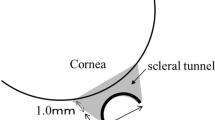Abstract
Purpose
To compare endothelial damage of the donor cornea in relation to the method of inserting the donor cornea into the recipient anterior chamber during Descemet-stripping automated endothelial keratoplasty (DSAEK).
Methods
Fifteen enucleated pig eyes were used. The donor corneoscleral buttons were mounted in an artificial anterior chamber. The anterior lamella was excised using a microkeratome and punched using a trephine. The following methods were employed to insert the donor cornea into the recipient anterior chamber: (1) The donor was folded over, grasped using forceps, and inserted (“taco” technique). (2) The forceps were inserted and the edge of the donor was grasped and dragged into the chamber. (3) A loop was made at the edge of the donor by suturing with nylon. A hook was inserted to drag the donor by the loop into the chamber. After insertion, the incision on the recipient eye was extended, and the donor cornea was removed for examination. After vital staining, the samples were examined under a light microscope and a scanning electron microscope.
Results
With the taco technique, endothelial damage (17.9%) was observed in areas where the forceps held the donor. In the drag technique using forceps, endothelial damage (17.3%) was observed where the forceps made contact and in the folds in this area. In the drag technique using a suture, endothelial damage (18.8%) was observed in the area of the needle puncture and in folds in this area.
Conclusion
The amount of endothelial damage did not differ significantly among the three different methods of donor insertion during DSAEK in this animal model, but each method exhibited a different endothelial damage pattern.
Similar content being viewed by others
References
Price FW, Price MO. Descemet’s stripping with endothelial keratoplasty in 200 eyes: early challenges and technique to enhance donor adherence. J Cataract Refract Surg 2006;32:411–418.
Melles GRJ, Eggiak FAGJ, Lander F, et al. A surgical technique for posterior lamellar keratoplasty. Cornea 1998;17:618–626.
Terry MA, Ousley PJ. Replacing the endothelium without corneal surface incisions or sutures: the first United States clinical series using the deep lamellar endothelial keratoplasty procedure. Ophthalmology 2003;110:755–764.
Terry MA, Ousley PJ. Deep lamellar endothelial keratoplasty: visual acuity, astigmatism, and endothelial survival in a large prospective series. Ophthalmology 2005;112:1541–1548.
Gorovoy MS. Descemet-stripping automated endothelial keratoplasty. Cornea 2006;25:886–889.
Busin M, Scorcia V. The DSAEK development and its modification for improved endothelial survival. In: Joo CK, editor. New horizons for non-surgical corneal reshaping and lamellar keratoplasty. Seoul: The Catholic University of Korea; 2007. p. 155–171.
Taylor MJ, Hunt CJ. Dual staining of corneal endothelium with trypan blue and alizarin red S: Importance of pH for the dye-lake reaction. Br J Ophthalmol 1981;65:815–819.
Koenig SB, Covert DJ, Dupps WJ, Meisler DM. Visual acuity, refractive error, and endothelial cell density six months after Descemet stripping and automated endothelial keratoplasty (DSAEK). Cornea 2007;26:670–674.
Davidson RS. Introduction to DSAEK surgery. In: Joo CK, editor. New horizons for non-surgical corneal reshaping and lamellar keratoplasty. Seoul: The Catholic University of Korea; 2007. p. 145–154.
Zhu Z, Rife L, Yiu S, et al. Technique for preparation of the corneal endothelium-Descemet membrane complex for transplantation. Cornea 2006;25:705–708.
Ignacio TS, Nguyen TT, Sarayba MA, et al. A technique to harvest Descemet’s membrane with viable endothelial cells for selective transplantation. Am J Ophthalmol 2005;139:325–330.
Ide T, Yoo SH, Goldman JM, Perez V, O’Brien TP. Descemetstripping automated endothelial keratoplasty: effect of inserting forceps on DSAEK donor tissue viability by using an in vitro delivery model and vital dye assay. Cornea 2007;26:1079–1081.
Saad HA, Terry MA, Shamie N, et al. An easy and inexpensive method for quantitative analysis of endothelial damage by using vital dye staining and Adobe Photoshop software. Cornea 2008;27:818–824.
Mehta JS, Por YM, Poh R, Beuerman RW, Tan D. Comparison of donor insertion techniques for Descemet stripping automated endothelial keratoplasty. Arch Ophthalmol 2008;126:1383–1388.
Author information
Authors and Affiliations
Corresponding author
About this article
Cite this article
Hwang, H., Kim, M. Endothelial damage of a donor cornea depending on the donor insertion method during Descemet-stripping automated endothelial keratoplasty in porcine eyes. Jpn J Ophthalmol 53, 523–530 (2009). https://doi.org/10.1007/s10384-009-0713-4
Received:
Accepted:
Published:
Issue Date:
DOI: https://doi.org/10.1007/s10384-009-0713-4




